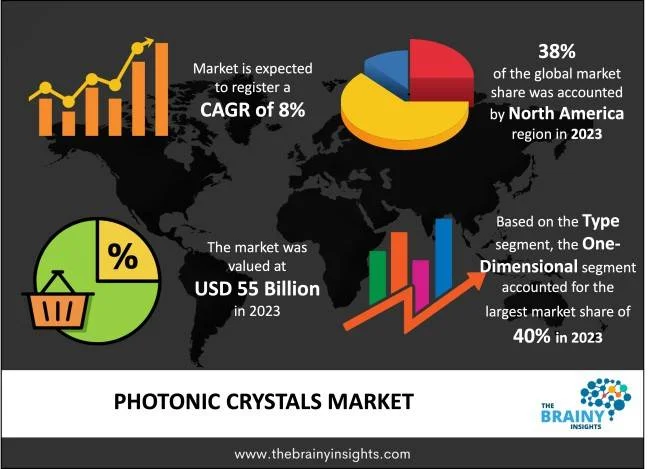Photonic crystals are optical materials that control the flow of light due to their periodic dielectric structures. Their unique ability to manipulate electromagnetic waves makes them highly useful in applications like optical fibers, LEDs, solar cells, sensors, lasers, and quantum computing. As demand grows for efficient, miniaturized, and high-speed photonic devices across industries like telecommunications, healthcare, and defense, the photonic crystals market is becoming increasingly significant.
The global photonic crystals market was valued at USD 55 billion in 2023 and grew at a CAGR of 8% from 2024 to 2033. The market is expected to reach USD 118.74 billion by 2033. The increasing demand for optical fibres will drive the growth of the global photonic crystals market.
Key Market Drivers
-
Growing Demand for Optical Communication: As data traffic surges globally, photonic crystals offer enhanced light manipulation capabilities crucial for high-speed fiber optics and telecom networks.
-
Rise in Photonic Devices: Increasing use of lasers, biosensors, and photodetectors in medical, industrial, and consumer electronics is driving adoption.
-
Energy Efficiency in LEDs and Solar Cells: Photonic crystals improve light extraction in LEDs and enhance light trapping in photovoltaics, making them key to energy-efficient technologies.
-
Advancements in Nanotechnology: Precision fabrication techniques like electron-beam lithography and nanoimprinting have enabled complex, reliable photonic crystal structures.
-
Defense and Aerospace Applications: Their use in stealth technology, optical filters, and sensors for surveillance boosts interest from defense sectors.
Market Restraints
-
Complex Fabrication Processes: Manufacturing photonic crystals with nanoscale precision is technologically challenging and costly.
-
High Initial Investment: Equipment and R&D costs are substantial, particularly for mass production and integration into devices.
-
Material and Design Limitations: Not all materials can be used to fabricate photonic crystals; designing for specific frequency ranges can be difficult.
-
Slow Commercialization: Despite academic research, commercial-scale adoption in some industries remains limited due to lack of standardization.
Regional Insights
-
North America: A leading market due to robust R&D infrastructure, strong presence of photonics companies, and high investments in defense, aerospace, and telecommunications. The U.S. leads in innovation and commercialization.
-
Europe: Significant investments in nanophotonics, especially in Germany, the UK, and the Netherlands. EU-funded projects also promote photonic research.
-
Asia-Pacific: Fastest-growing region led by Japan, China, and South Korea. Strong manufacturing base, expanding semiconductor industry, and government support for photonics R&D fuel growth.
-
Latin America: Emerging market, with potential in telecommunications and solar energy applications, particularly in Brazil and Mexico.
-
Middle East & Africa: Gradual adoption driven by growing investments in smart cities, solar energy, and telecommunications infrastructure.
Challenges and Opportunities
Challenges:
-
Scalability Issues: While photonic crystals are highly effective at the micro level, scaling them for large-area applications remains a technical barrier.
-
Integration with Existing Systems: Compatibility with traditional electronic components and manufacturing processes can be complex.
-
Lack of Awareness and Expertise: In some regions, limited awareness about photonic technologies and a lack of skilled labor hinder adoption.
Opportunities:
-
Emerging Applications in Quantum Computing: Photonic crystals are essential for building photonic circuits and quantum photonic networks.
-
Expansion in Biosensing and Healthcare: Potential for ultra-sensitive, label-free biosensors used in diagnostics and medical imaging.
-
Smart Lighting and Displays: Integration into next-gen OLEDs and microLEDs for brighter, more efficient display technologies.
-
Renewable Energy: Enhancing solar panel efficiency through advanced light-trapping techniques.
-
Metamaterials and Optical Cloaking: Use in advanced materials that manipulate light in novel ways, such as invisibility cloaks and ultra-efficient lenses.
Key Trends
-
Miniaturization of Optical Components: Push toward compact, on-chip photonic systems for faster data processing and communication.
-
3D Photonic Crystals: Rising research interest in full 3D structures offering more control over light propagation.
-
Hybrid Integration: Combining photonic crystals with other nanostructures or metamaterials for enhanced functionality.
-
Flexible and Printable Photonic Devices: Research into flexible substrates opens up potential in wearable and conformable electronics.
-
AI-Driven Design and Simulation: Machine learning is being used to optimize crystal structures and performance parameters rapidly.
Key Players
-
Opalux Inc. – Specializes in photonic crystal-based sensors and display materials.
-
Advanced Photonic Crystals, LLC – Focuses on commercial photonic crystal manufacturing for optical and LED applications.
-
NanoPhotonica – Develops nanophotonic materials, including photonic crystals, for display and sensor markets.
-
Photon Bandwidth Technologies – Offers photonic crystal technology for optical communication and data center solutions.
-
Hamamatsu Photonics K.K. – Japanese firm involved in photonics R&D and components, including advanced sensors and detectors.
-
Corning Inc. – Works with photonic materials in optical fibers and advanced communication solutions.
-
NKT Photonics – Provides photonic crystal fibers for scientific and industrial laser applications.
-
Photonic Lattice, Inc. – Japanese company known for producing photonic crystal-based LED lighting solutions.
Request to Download Sample Research Report- https://www.thebrainyinsights.com/enquiry/sample-request/14167
Conclusion
The photonic crystals market stands at the forefront of next-generation optical technologies, offering immense potential across multiple high-tech industries. While fabrication challenges and high initial costs exist, the push for energy efficiency, faster communications, and compact photonic devices is expected to drive sustained growth. As research continues to bridge the gap between lab and commercialization, photonic crystals are likely to become foundational to innovations in computing, energy, healthcare, and beyond.






